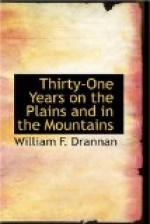The first herd of buffalo we saw was along a stream known as Cow Creek and which is a tributary to the Arkansas river. We could see the herd feeding along the hills in the distance.
Here was good camping ground and it was time to halt for the night. So as soon as we had decided on the spot to pitch camp, Uncle Kit directed me to go and kill a buffalo, so that we might have fresh meat for supper.
That suited me, exactly, for I was eager to get a shot at such big game.
Uncle Kit told me to follow up the ravine until opposite the herd and then climb the hill, but to be careful and not let the buffalo see me.
I followed his instructions to the dot, for I had come to believe that what Kit Carson said was law and gospel, and what he didn’t know would not fill a book as large as Ayer’s Almanac. I was right, too, so far as plainscraft was concerned.
Uncle Kit had also directed me to select a small buffalo to shoot at, and to surely kill it, for we were out of meat.
It so happened that when I got to the top of the hill and in sight of the herd again the first animal that seemed to present an advantageous shot was a two-year-old heifer.
I dropped flat on the ground and crawled toward her, like a snake. Once she raised her head, but the wind being in my favor, she did not discern me, but put her head down and went on feeding. I succeeded in crawling quite close enough to her, drew a bead on her and fired. At the crack of the rifle she came to the ground, “as dead as a door-nail,” much to the surprise of Uncle Kit and Mr. Hughes, who were watching me from a distance.
When the animal fell, I threw my hat in the air and gave a yell that would have done credit to an Apache warrior.
Uncle Kit and I dressed the buffalo and carried the meat into camp while Mr. Hughes gathered wood for the night-fires.
I could scarcely sleep that night for thinking of my buffalo, and could I have seen Henry Becket that night I would almost have stunned him with my stories of frontier life.
The novice is ever enthusiastic.
The following morning we woke up early, and off, still heading up the Arkansas river for Bent’s Fort, and from here on the buffalo were numerous, and we had that sort of fresh meat until we got good and tired of it.
The second day out from Cow Creek, in the afternoon, we saw about twenty Indians coming towards us. At the word, “Indians,” I could feel my hair raise on end, and many an Indian has tried to raise it since.
This was my first sight of the red man. He looked to me to be more of a black man.
Uncle Kit asked Mr. Hughes what Indians he thought they were. The reply was that he thought them to be Kiowas, and on coming up to them the surmise proved to be correct.
They were Black Buffalo, the chief of the Kiowas, and his daughter, accompanied by twenty warriors.




